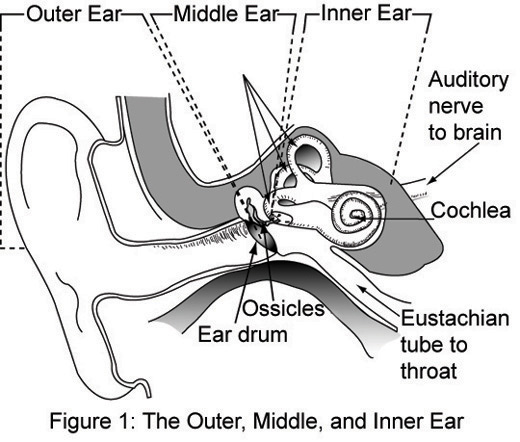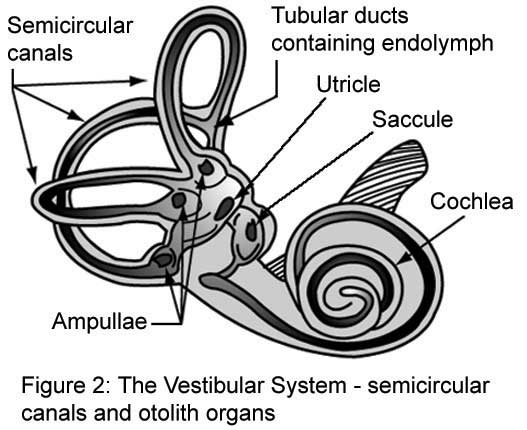Written by Stephanie Anderson, Kaylyn Leonard, Ronald Romero, and Jada Zevenbergen
Sight, touch, smell, taste, hearing … and spatial orientation?


If you were asked, “how many senses do you have?”, most likely you would answer five: sight (vision), touch (somatosensation), smell (olfaction), taste (gustation), and hearing (audition); but did you know that we actually have six senses? This sixth sense is called our vestibular sense. The vestibular sense is composed of our vestibular organs, located in the inner ear next to the cochlea.
The vestibular system is responsible for our spatial orientation by sensing the motion of our head, regulating our balance, and contributing to our sense of tilt. (Wolfe, 2021). When combined with visual cues, the vestibular system also forms our sense of equilibrium, or our state of balance (Wolfe, 2021). For example, our vestibular system allows us to have clear vision when we move and maintain our balance when we walk. This also means that when our vestibular system and visual cues are misaligned, our sense of equilibrium is disrupted. A disruption of our sense of equilibrium results in the feeling of imbalance, or unsteadiness. Oftentimes, you may not even be aware of your vestibular sense until you experience the feeling of dizziness, unsteadiness, or imbalance. These feelings of imbalance can occur in your everyday life, whether you recognize your vestibular sense is the contributing factor or not.
Illusions of self-motion
Have you ever been sitting at a stoplight and suddenly feel as if you are moving backward, but in reality, the car next to you was moving forward? You may have even checked to make sure your foot was still on the brakes. Don’t worry, you are not alone! In this situation, you are experiencing a type of imbalance due to a disruption between your vestibular system and vision. This experience is called an illusion of self-motion, or more specifically the sensation of vection, where you perceive that your body is moving despite no movement actually taking place (Wolfe, 2021). In other words, your visual cues are signaling to your brain that you are moving but your body is actually stationary, resulting in the sensation of vection. For example, when you are stopped at the stoplight and see the car next to you in motion, your visual cues recognize that your surrounding environment is moving and perceive that you must be moving too. These visual cues send signals to your brain to report that your body is also in motion; despite your vestibular system saying otherwise. Your vestibular system, you know the sense that recognizes your spatial orientation, correctly identifies the stillness of your body; however the visual cues override the cues provided by your vestibular system. This results in your perception of movement, although you remain perfectly still. Simply put, it is easier for the brain to comprehend that you are moving rather than that the world around you is moving. This disconnect between your vestibular system and vision results in the sensation of vection. The sensation of vection can be experienced in your everyday life, as illustrated by this stoplight example, but it also can be artificially induced.
Virtual Reality Relations
Vection, remember, when you perceive your body is in motion despite no movement, can be visually and artificially induced. The advancement of technology has taken advantage of the ability to artificially induce the feeling of imbalance to market and sell products. A new and increasingly common product you may have previously heard of is virtual reality, which actually utilizes the sensation of vection! Virtual reality is an immersive experience in which you are “teleported” into a new world through audio and visual cues. Virtual reality is achieved through a headset that covers your eyes and elicits images and video footage that aims to change your perception of reality. Vision signals are continuously displayed through the headsets of virtual reality, signaling to a user that they are moving in a certain direction. However, there is a disconnect between the user’s visual cues, signaling they are moving, and the vestibular system, signaling they are not moving (Gallagher et al., 2019). Again, this disconnect leads to the sensation of vection, or state of imbalance. In contrast to the stoplight example, where this sensation of vection was unexpected and unpleasant, this sensation of vection in virtual reality is wanted to create a unique experience! This advanced technology has given a new meaning to the sensation of vection. Experience the thrill of virtual reality through the video below!
https://youtu.be/hNAbQYU0wpg?t=34
Tip: Click and hold the arrows in the top left of the video to move your view around the experience!
Final Thoughts
The vestibular sense is an important part of our everyday lives. We may not realize it but the vestibular system plays a major role in everyday tasks such as standing up or walking. As the vestibular sense is not our most obvious sense, other senses often overpower the signals sent to our brains by the vestibular system — such as when you feel like you are moving but in reality are staying still. An imbalance in our vestibular system can create the feeling of vection, and with advancements in technology continuing, you can be sure that virtual reality will not be the only time you experience artificially induced vection! With your new knowledge, try to identify times throughout the day when your vestibular system is at work, I’m sure it’s more often than you expect.
References
Gallagher, M., Dowsett, R., Raffaella, E. (2019). Vection in virtual reality modulates vestibular-evoked myogenic potentials. European Journal of Neuroscience, 50(10), 3557-3565. doi:10.1111/ejn/14499
Wolfe, J.M., Kleunder K., Levi D., Bartoshuk, L., Herz, R., Klatzky, R., Merfeld, D. (2021). Sensation & Perception (6th ed). Sinauer Associates, Inc.
3D VR 360 Videos. (2019). VR 360 Video of Top 5 Roller Coaster Rides 4K Virtual Reality [Video]. YouTube. https://www.youtube.com/watch?v=hNAbQYU0wpg.